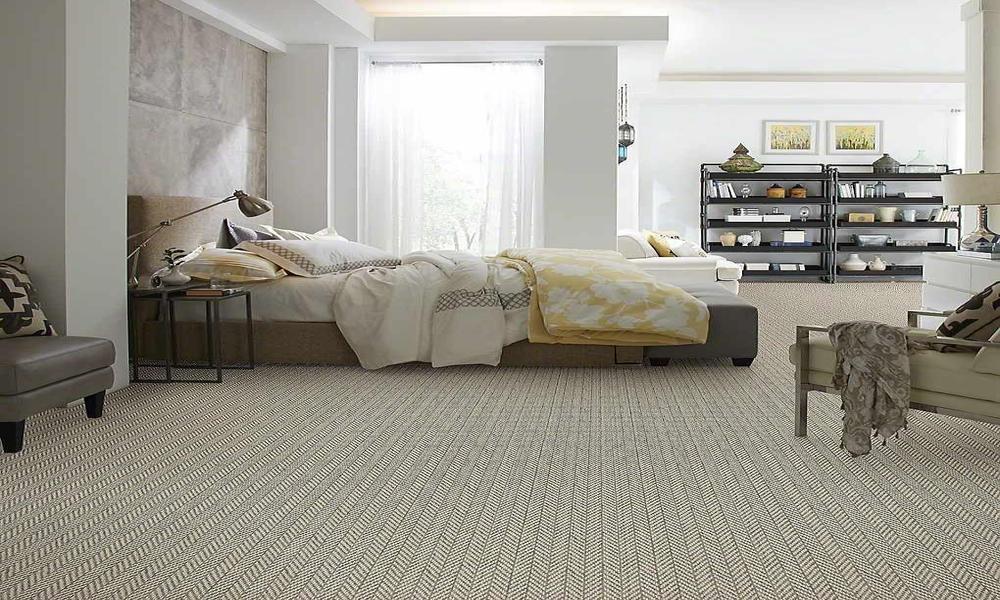Yes, wall-to-wall carpets can be installed over existing flooring in certain cases. However, there are a few considerations to keep in mind:
Condition of the Existing Flooring:
The condition of the existing flooring is crucial. It should be clean, dry, and in good condition. Any damage or unevenness in the existing floor may affect the installation and performance of the carpet. It’s important to assess the condition of the floor and make any necessary repairs or adjustments before installing the carpet.
Height and Transition Issues:
Adding a wall-to-wall carpet over existing flooring may result in a higher floor height, which can create transition issues between rooms or adjacent flooring surfaces. It’s important to consider the height difference and whether it may cause tripping hazards or affect the functionality of doors and transitions. Adjustments, such as using transition strips or trimming doors, may be necessary.
Moisture Concerns:
If the existing flooring is prone to moisture issues, such as in bathrooms or basements, it may not be suitable for carpet installation. Moisture can lead to mold, mildew, and damage to the carpet and subfloor. Ensure the existing flooring is adequately sealed and waterproofed before considering carpet installation.
Carpet Padding:
It’s generally recommended to install carpet padding under wall-to-wall carpets. However, the existing flooring should be evaluated to determine if it provides a suitable base for the carpet and padding. Some flooring materials, such as thick carpets or padded vinyl, may not require additional padding.
How long can you expect a wall-to-wall carpet to last with proper care?
Here are some factors that can influence the longevity of a wall-to-wall carpet:
Quality of the Carpet: Higher-quality carpets are often more durable and resistant to wear and tear. Carpets made with high-quality materials and construction techniques tend to have a longer lifespan compared to lower-quality options.
Foot Traffic: The amount of foot traffic the carpet is exposed to plays a significant role in its wear and durability. High-traffic areas like hallways, living rooms, and entryways tend to experience more wear and may require more frequent replacement compared to low-traffic areas.
Maintenance and Cleaning: Proper care and maintenance can extend the lifespan of a wall-to-wall carpet. Regular vacuuming, prompt removal of spills and stains, and periodic professional deep cleaning help keep the carpet in good condition and prevent dirt and debris from accumulating and causing damage.
Installation Quality: A proper installation is crucial for the longevity of a carpet. Poor installation can lead to premature wear, wrinkling, and other issues that may shorten the carpet’s lifespan. It’s important to hire professional installers who follow industry best practices.
Environmental Factors: Environmental factors such as exposure to direct sunlight, humidity, and moisture can impact the lifespan of a carpet. Excessive sunlight can cause fading and deterioration, while high humidity or moisture can lead to mold, mildew, and damage to the carpet and underlying subfloor.
It’s important to note that the estimated lifespan is just a general guideline, and individual circumstances may vary. Regular assessment of the carpet’s condition and consulting with professionals can help determine if replacement or repairs are needed. Additionally, factors like changes in personal preferences or redecorating may also influence the decision to replace a carpet even if it’s still in good condition.


 Why You Should Join a Minecraft Towny Server Today
Why You Should Join a Minecraft Towny Server Today  The Science Supporting Natural Wellness from Green Kratom
The Science Supporting Natural Wellness from Green Kratom  Myths About CBD That Need to Be Debunked
Myths About CBD That Need to Be Debunked  How to protect yourself when using a deep web search engine?
How to protect yourself when using a deep web search engine?  Are CBD Gummies for Anxiety a Miracle Cure?
Are CBD Gummies for Anxiety a Miracle Cure?  Liquid Vaults: Ether.fi unlocks automated DeFi earnings
Liquid Vaults: Ether.fi unlocks automated DeFi earnings  How to share legal advice securely using self-destructing notes?
How to share legal advice securely using self-destructing notes?  Maximize your wins: Top Strategies for Football Betting in Online Casinos
Maximize your wins: Top Strategies for Football Betting in Online Casinos  Five Businesses You Could Start Today for Additional Income
Five Businesses You Could Start Today for Additional Income 